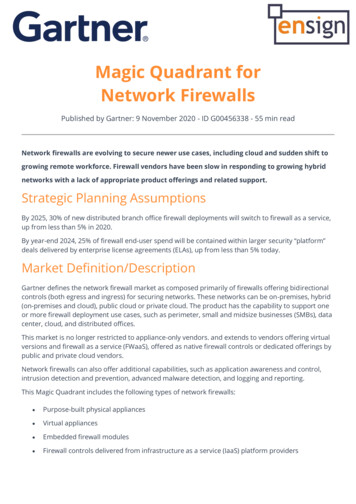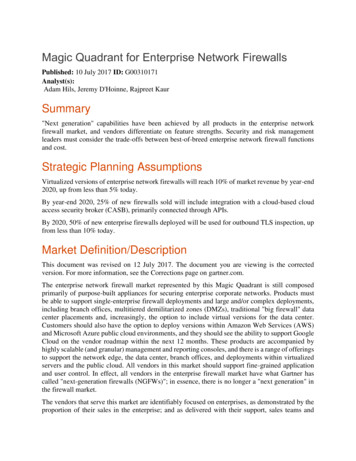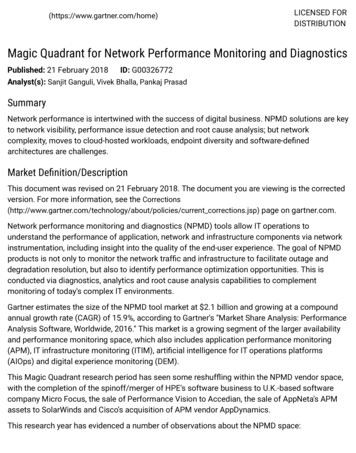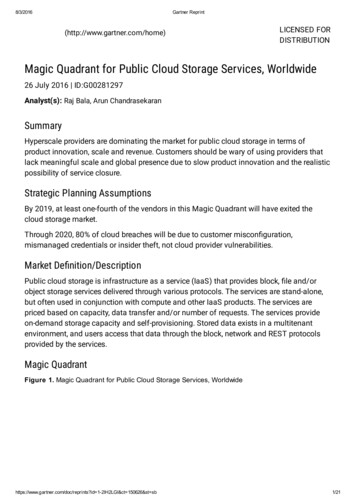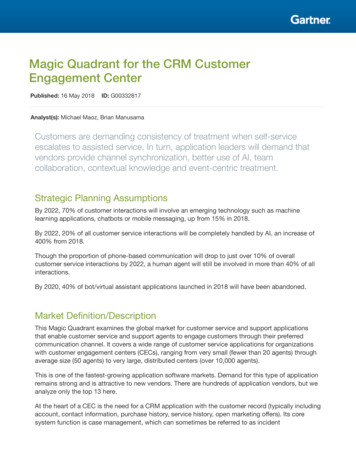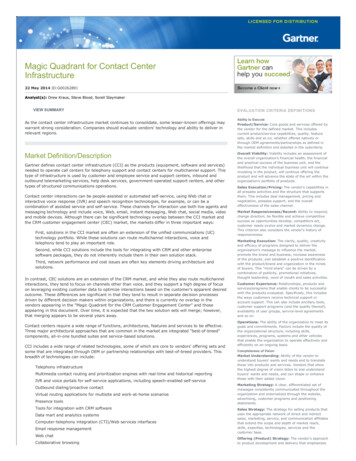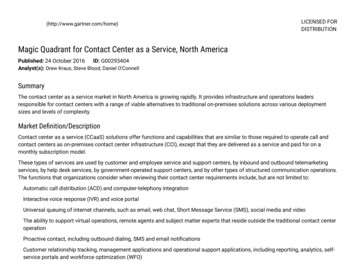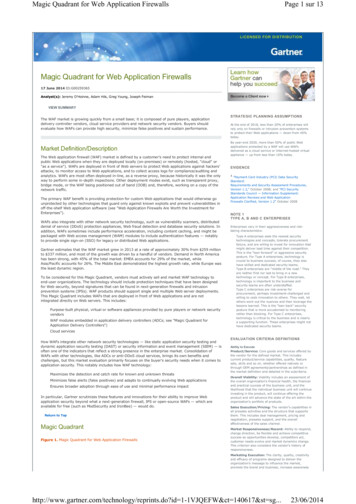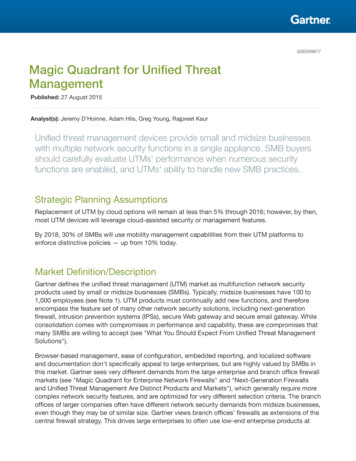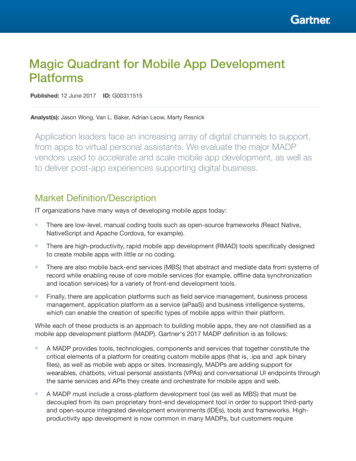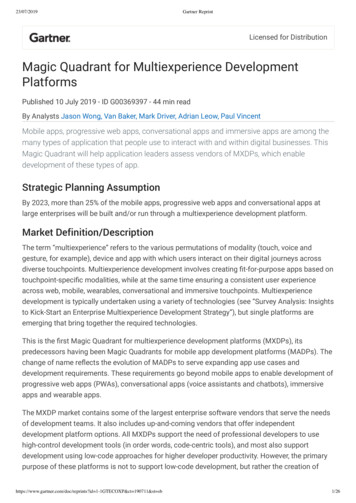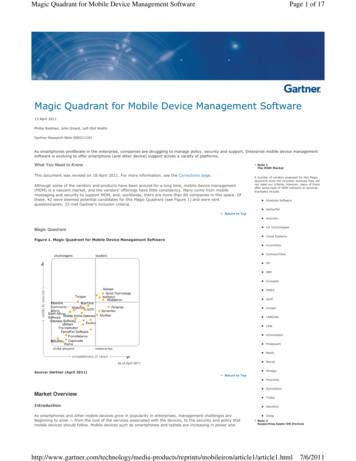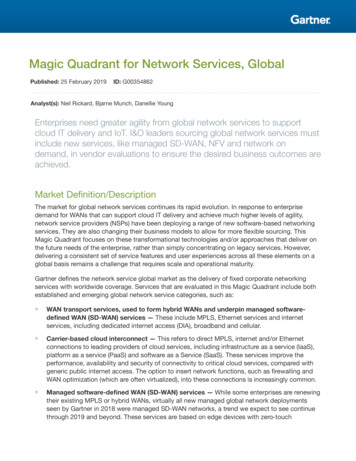
Transcription
Magic Quadrant for Network Services, GlobalPublished: 25 February 2019ID: G00354862Analyst(s): Neil Rickard, Bjarne Munch, Danellie YoungEnterprises need greater agility from global network services to supportcloud IT delivery and IoT. I&O leaders sourcing global network services mustinclude new services, like managed SD-WAN, NFV and network ondemand, in vendor evaluations to ensure the desired business outcomes areachieved.Market Definition/DescriptionThe market for global network services continues its rapid evolution. In response to enterprisedemand for WANs that can support cloud IT delivery and achieve much higher levels of agility,network service providers (NSPs) have been deploying a range of new software-based networkingservices. They are also changing their business models to allow for more flexible sourcing. ThisMagic Quadrant focuses on these transformational technologies and/or approaches that deliver onthe future needs of the enterprise, rather than simply concentrating on legacy services. However,delivering a consistent set of service features and user experiences across all these elements on aglobal basis remains a challenge that requires scale and operational maturity.Gartner defines the network service global market as the delivery of fixed corporate networkingservices with worldwide coverage. Services that are evaluated in this Magic Quadrant include bothestablished and emerging global network service categories, such as: WAN transport services, used to form hybrid WANs and underpin managed softwaredefined WAN (SD-WAN) services — These include MPLS, Ethernet services and internetservices, including dedicated internet access (DIA), broadband and cellular. Carrier-based cloud interconnect — This refers to direct MPLS, internet and/or Ethernetconnections to leading providers of cloud services, including infrastructure as a service (IaaS),platform as a service (PaaS) and software as a Service (SaaS). These services improve theperformance, availability and security of connectivity to critical cloud services, compared withgeneric public internet access. The option to insert network functions, such as firewalling andWAN optimization (which are often virtualized), into these connections is increasingly common. Managed software-defined WAN (SD-WAN) services — While some enterprises are renewingtheir existing MPLS or hybrid WANs, virtually all new managed global network deploymentsseen by Gartner in 2018 were managed SD-WAN networks, a trend we expect to see continuethrough 2019 and beyond. These services are based on edge devices with zero-touch
configuration, able to dynamically route traffic over different links based on policies undercentral policy management control (see “Technology Insight for Software-Defined WAN [SDWAN]”). SD-WAN improves WAN agility by allowing easier and faster deployment of new sites,flexibility in the link types used, and simplified addition of new applications to the network. Inaddition, SD-WAN services typically provide significantly enhanced levels of application visibilitycompared to traditional managed router services. Network on-demand services — Network on-demand services from NSPs enable enterprisesto make real-time changes to access/port bandwidth, change the WAN service types deliveredover a network port and, in some cases, even add and remove endpoints, such as connectionsto cloud providers all under software control. They are controlled by the enterprise, via theprovider’s web portal or APIs. Many providers are using software-defined networking (SDN) todeliver this functionality. Network function virtualization (NFV) services — This functionality is the replacement forpurpose-built hardware devices, such as routers, security devices or WAN optimizers, withsoftware running on industry-standard hardware equipment (see “Network FunctionVirtualization Will Enable Greater WAN Agility and Flexibility”). It can be run in virtual customerpremises equipment (vCPE), which consists of on-site x86-based servers, supporting multiplevirtualized network functions. Alternatively, some functions can run NFV service nodes, locatedin the provider’s network; although, in this case, some form of on-premises device will still beneeded. NFV allows network functions to be activated on demand and consumed on an “as aservice” basis, seeking to improve both the agility and cost-effectiveness of the enterpriseWAN. vCPE — vCPE is the use of industry-standard, x86-based servers, rather than function-specificappliances, at enterprise premises to deliver enterprise network edge functions, such as WANedge routers, including SD-WAN, WAN optimization controllers (WOCs), and security functionssuch as firewalls. (See “Innovation Insight for Virtual CPE.”)What’s Changed?In the past 12 months, Gartner has observed continued evolution of enterprise requirements andbuying criteria for global networks. Enterprises are focusing on increasing the agility of theirnetworks and on services that can enable their adoption of cloud IT delivery and eventual adoptionof the Internet of Things (IoT). This is leading to most new global networks being based on SD-WANand making greater use of the internet as a primary WAN transport.Additionally, enterprises are more willing to utilize smaller providers and innovative servicesconsumed on an as-a-service basis. This places less emphasis on larger providers, network scaleand the availability of large numbers of provider staff to deliver customized capabilities to addresssite- or application-specific requirements.Both enterprises and network service providers are taking advantage of the marketplace created bycolocation hubs, such as Equinix and Digital Realty, to allow them to source access that is distanceinsensitive at the national or even regional level. This simplifies the overall design and reduces theneed for the deployment of large numbers of network points of presence (POPs; see “Five KeyFactors to Prepare Your WAN for Multicloud Connectivity”). However, coverage for at least thePage 2 of 29Gartner, Inc. G00354862
country level is still important, both to reduce costs and to improve performance when accessingcloud services and network-based virtual functions. The trend of moving away from customizedsolutions toward standard off-the-shelf managed services continues, with more and more servicesconsumed on an as-a-service basis. Although uptake of NFV and vCPE has been slower thanexpected due to relatively high prices and technological limitations of some early implementations,the momentum behind these services is increasing, as enterprises see the value of the increasedagility they can bring. (For example, in the 2018 iteration of this Magic Quadrant, less than 50% ofproviders offered these services. In this 2019 edition, that number is almost 90%.)Network on-demand services are gaining in popularity, not to reduce costs by varying WANbandwidth over the course of the day or week, but rather to dynamically adjust the capacity ofdifferent network services (e.g., Shrink MPLS and grow internet access as SD-WAN is rolled out).This allows enterprises to accommodate new applications and even create connections to newdestinations, such as additional cloud providers, on demand, potentially allowing for dynamic loadbalancing of cloud providers and cloud performance optimization. However, these offerings are intheir infancy in terms of functionality and coverage.While delivering against a strong technological roadmap is important, it must be combined withgood operational performance to deliver and sustain these services. Some service providers havebeen struggling to deliver the new capabilities they are offering with the levels of quality enterprisesrequire.To strengthen the focus of this research on these key trends and capabilities, we are no longerevaluating SIP trunk services, managed LANs or wireless LANs (WLANs). SIP trunk services will becovered in a separate Market Guide.The inclusion and exclusion criteria for this year’s Magic Quadrant, although similar to prior years,have been adjusted to reflect these trends.Gartner, Inc. G00354862Page 3 of 29
Magic QuadrantFigure 1. Magic Quadrant for Network Services, GlobalSource: Gartner (February 2019)Vendor Strengths and CautionsAT&TBased in Dallas, Texas, AT&T is a major U.S. provider of fixed and mobile network services and hascompleted the acquisition of media and entertainment company Time Warner.Page 4 of 29Gartner, Inc. G00354862
AT&T has an extensive global MPLS and Ethernet network, with broad reach. Its internet backbone,although high-capacity, has much less coverage than its other services. Its NetBond carrier-basedcloud interconnect offer connects to 12 cloud providers in 24 cities.AT&T was an early adopter of NFV and vCPE with its FlexWare offering. It was a little later inadopting managed SD-WAN, but now has a differentiated network-based SD-WAN capability and islaunching additional offers based on multiple vendors. This rapid rollout has come, however, at theexpense of some platform fragmentation.In the past 12 months, AT&T has become more willing to pursue opportunities that do notnecessarily have a substantial U.S. component.Global enterprises of all sizes should evaluate AT&T for global networking services.Strengths AT&T’s FlexWare is a leading NFV/vCPE suite with a range of deployment options includingvCPE edge devices and 160 NFV service nodes. It supports multiple virtual network functions(VNFs) including routing SD-WAN, security and WAN optimization (although some of theseVNFs are only available on an unmanaged basis). AT&T offers SD-WAN services based on VMware (formerly VeloCloud), with POP-basedgateways to improve performance and scalability and to simplify migration. SD-WAN based on128 Technology was also launched in 2018, and Cisco SD-WAN (Viptela) is planned for 2019. 2018 saw a significant expansion of AT&T’s Ethernet footprint, which now allows for reach to 41countries, with up to 100 Gbps access available.Cautions AT&T’s additional SD-WAN offerings, from Cisco and AudioCodes/128 Technology, are basedon separate NFV platforms from its primary FlexWare offering, limiting enterprises’ ability to takeadvantage of the full suite of FlexWare capabilities. AT&T’s own global internet service (AT&T Dedicated Internet Global [ADIG]) has limitedcoverage compared to the other leading providers in this Magic Quadrant. As a result, AT&Trelies more heavily on dedicated internet access services from other providers when buildinghybrid or SD-WAN networks. Some Gartner clients are reporting increased levels of dissatisfaction with the quality of thevendor’s service delivery and support.BTHeadquartered in London, BT is a major provider of fixed-line, mobile and broadband services in theU.K. Its Global Services division offers global networking and IT services to enterprise and publicsector customers.Gartner, Inc. G00354862Page 5 of 29
BT has an extensive global network, with especially strong coverage in Europe and Latin America.BT has stated that it plans to move to a more “asset light” approach to its global network. As aresult, Gartner expects that it will dispose of some of its in-country network assets; although BTexpects to retain access to this infrastructure through commercial agreements.In the past 12 months, BT has significantly enhanced its enterprise network portfolio, rolling outadditional managed SD-WAN services and an NFV/vCPE offer, in addition to its existing provenhybrid WAN capabilities and carrier-based cloud interconnect offer.In 2018, BT Global Services announced that it intends to focus on its largest 800 enterprise clients.Large global enterprises should consider BT for global networking services.Strengths BT offers managed SD-WAN globally with multiple offers based on Nuage Networks from Nokia,Cisco SD-WAN (Viptela), Cisco SD-WAN (Meraki), Infovista and Riverbed. BT has a comprehensive NFV/vCPE offer with multiple virtual network functions in routing, SDWAN, security, visibility, and WAN optimization, and a bring-your-own VNF capability,deployable from vCPE devices and 12 NFV service nodes. The vendor has a strong carrier-based cloud interconnect offer with eight cloud services and 16cities supported globally. These support the insertion of virtualized network services, such asfirewalling and WAN optimization, into the connections.Cautions BT has indicated that it is no longer focusing on directly pursuing business from smallermultinationals, including some of the more than 4,400 that are currently its clients. However, itwill continue to serve these customers via regional sales teams, desk-based sales and indirectpartners. BT’s plans for network on-demand services are limited to bandwidth on-demand for singleservices, with no announced plans for the dynamic addition of multiple services and newendpoints. In the U.S. market, BT’s network and sales coverage is not as strong as that of its U.S.headquartered competitors.CenturyLinkCenturyLink is a major U.S. network service provider based out of Louisiana, with extensive globalnetworking capabilities largely arising from its 2017 acquisition of Level 3 Communications.CenturyLink’s global network includes Ethernet, MPLS and internet services, and is strongest in theU.S., Europe and Latin America.Page 6 of 29Gartner, Inc. G00354862
CenturyLink’s managed service offerings, especially SD-WAN and NFV/vCPE, are more limited thanthose of its leading competitors.Global enterprises with geographic requirements focused on some or all of the U.S., Latin Americaand Europe should consider CenturyLink.Strengths CenturyLink has a strong network on-demand offering supporting Ethernet, MPLS and internet,and allowing connection to cloud endpoints. The vendor’s carrier-based cloud interconnect offering supports connection to six major cloudproviders in 40 cities globally, with support for dynamic capacity and connections. CenturyLink’s network coverage in North America and South America is especially strong.Cautions Compared to other providers in this Magic Quadrant, CenturyLink’s SD-WAN offering is limited,with its Versa Networks-based offering only available in 37 countries globally and its Cisco SDWAN (Meraki and Viptela) offerings available in the U.S. only. However, CenturyLink plans toexpand coverage of Versa Networks’ offering to more than 60 countries and expand its CiscoSD-WAN (Viptela)-based offer internationally in 2019. CenturyLink’s current NFV offering is very basic, with a single VNF each for routing, SD-WANand security available in on-premises vCPE devices, and security and routing VNFs available ina small number of NFV service nodes. However CenturyLink has plans to expand both the VNFssupported and number of service nodes during 2019. CenturyLink has limited coverage of the Asia/Pacific region, although this has been improving,and very limited coverage in Africa and the Middle East.Global Cloud XchangeGlobal Cloud Xchange (GCX) is the global networking arm of Reliance Communications, a largeIndian network service provider.GCX has rolled out MPLS and Ethernet POPs, with a focus on proximity to its extensive underseacable infrastructure that connects India, China, the Asia/Pacific region, and the Middle East to theU.S. and Europe. GCX also has cloud gateways in 15 cities, connected to five global cloudproviders.GCXs internet network is significantly smaller than its MPLS footprint, limiting its ability to controlinternet quality in SD-WAN deployments, although it does have extensive capabilities at managingthird-party ISPs.Gartner, Inc. G00354862Page 7 of 29
GCX was one of the first providers to offer managed hybrid WANs and has enhanced this offering toprovide managed SD-WAN based on a large number of vendors. However, its NFV/vCPEcapabilities are currently limited.GCX is best-suited for global networks that are primarily focused on linking sites spread acrossAsia/Pacific, the Middle East, the U.S. and Europe, or for enterprises requiring very-high-bandwidthservices between major global hubs.Strengths GCX offers managed SD-WAN services based on Juniper Networks, Cisco SD-WAN (Meraki),Silver Peak and Riverbed, with additional vendors in test, although solutions from leadersVMware and Cisco SD-WAN (Viptela) are yet not supported. GCX has a more extensive global cable network than most providers, which allows it to addresshigh-bandwidth needs between major global hub locations with good price performance. GCX has a strong track record of delivering hybrid WANs, including the management of a widerange of access providers and customer-provided access.Cautions GCX does not currently operate any NFV-based service nodes, but vCPE services are plannedfor 1Q19. GCX has limited network on-demand services that allow bandwidth adjustment for internet andMPLS services, but not Ethernet services; and it does not allow the addition of new services orendpoints. GCX’s own network coverage in Eastern Europe, Latin America and Africa is not as extensive asthat of leading providers in this Magic Quadrant. Instead, the vendor relies on partners for depthof coverage in these regions.GTTGTT is a provider of global enterprise networking services based in McLean, Virginia. GTT hasgrown rapidly through acquisitions, with its largest acquisition to date being European networkservice provider Interoute, which closed on 31 May 2018.GTT offers a broad set of network services, including fiber, Ethernet, MPLS, internet and managednetwork services, throughout North America and Western Europe, with more limited coverage inother regions. Its carrier-based cloud interconnect connects to 10 cloud providers in 14 cities.Through the acquisition of network aggregator Global Capacity in 2017, GTT gained an extensivein-house access provider management capability.GTT offers managed SD-WAN from two vendors, and NFV/vCPE from both vCPE devices and NFVservice nodes in 16 cities.Page 8 of 29Gartner, Inc. G00354862
GTT should be evaluated for global networks, particularly those requiring strong coverage in NorthAmerica and Europe.Strengths GTT offers a managed SD-WAN solution based on Silver Peak and VMware (VeloCloud). The vendor delivers NFV in vCPE devices and NFV service nodes in 16 cities, with multiple SDWAN, security and WAN optimization VNFs. GTT operates one of the largest internet backbones in the world, which enables it to deliver ahigh level of internet performance around the globe.Cautions GTT currently lacks a network on-demand capability. The vendor will have to manage integration of the large number of companies it has acquired,creating a degree of operational risk. GTT lacks network coverage in Latin America, the Asia/Pacific region and Africa, compared toleading providers in this Magic Quadrant. Instead, the provider relies on partners for depth ofcoverage in these regions.MasergyMasergy is a privately held network service provider based in Plano, Texas, and owned by BerkshirePartners. While it is the smallest of the providers in this research, based on size and revenue,Masergy remains successful in its efforts to target global enterprises seeking customized networkservices that leverage a software-defined platform.Masergy’s network offers MPLS, Ethernet and internet services from a software-defined backbonewith a network on-demand capability allowing services and capacity to be changed on demand.Masergy leverages both proprietary and third-party hardware (including from Fortinet and SilverPeak) to deliver managed SD-WAN services. For several years, Masergy has delivered NFV servicesas its standard approach to delivering network edge functions, supporting both vCPE devices andNFV service nodes.Organizations should evaluate Masergy if they require network services in the major globaleconomies.Strengths Masergy provides a mature global NFV and vCPE platform offering with a wide range of VNFs,including SD-WAN, router, firewall,
WAN optimization (which are often virtualized), into these connections is increasingly common. . purpose-built hardware devices, such as routers, security devices or WAN optimizers, with software running on industry-standard hardware equipment (see “Network Function . Cisco SD-WAN
